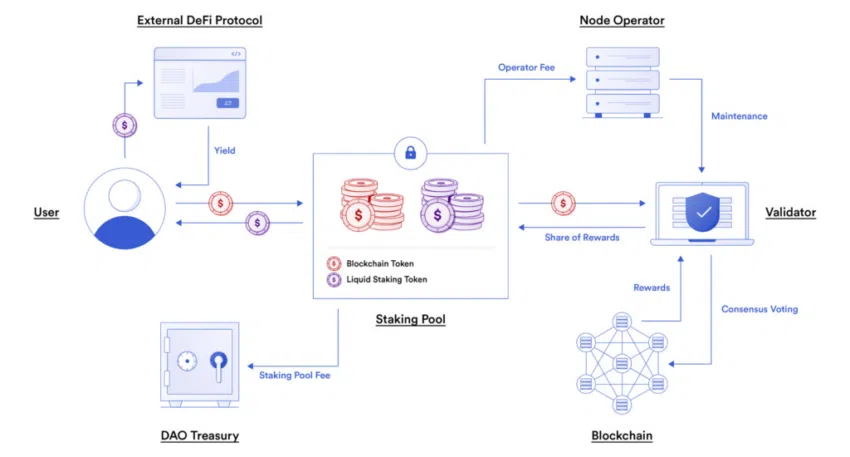
In the world of cryptocurrency, decentralized financial instruments (DeFi) have brought about a significant revolution, offering asset holders the opportunity to earn passive income.
Among the most popular methods to achieve this in DeFi is through staking. However, traditional staking comes with a limitation – once tokens are locked, they cannot be utilized for transactions or used as collateral for potentially higher returns.
In this article, MarketsXplora explains what is liquid staking in crypto and how it addresses this particular challenge.
In this article
- What is liquid staking in crypto?
- How does liquid staking work?
- What are liquid staking derivatives?
- Staking vs liquid staking – What is the difference?
- Pros & Cons of liquid staking
- Liquid Staking Protocols
What is liquid staking in crypto?
Liquid staking in crypto presents an innovative solution that allows users to lock their tokens within smart contracts while still maintaining access to liquidity. This is achieved through the issuance of derivative tokens by pool operators, with these tokens being backed by the assets staked in an equal proportion.
As a result, users have the flexibility to trade these derivative tokens or utilize them to generate additional income through various DeFi strategies.
How does liquid staking work?
How liquid staking functions is very straightforward. Users deposit their funds into an escrow account managed by a smart contract. In return, the platform issues tokenized versions of the assets, each holding an equivalent value.
This way, users can benefit from staking rewards while simultaneously having the flexibility to use the tokenized assets in other transactions or strategies within the DeFi ecosystem.

Derivative tokens can be withdrawn outside the platform, stored elsewhere, exchanged or spent without affecting the initial deposit. However, in order to access the assets added to the staking, it is necessary to exchange the tokenized versions back.
What are liquid staking derivatives?
Liquid staking derivatives are tokens issued by platforms that offer liquid staking services. These tokens represent the staked assets held in smart contracts, allowing users to maintain liquidity while earning staking rewards. Users can trade these derivative tokens or utilize them in various DeFi protocols to generate additional income.
Traditional staking vs liquid staking – What is the difference?
Staking vs liquid staking are methods used in the DeFi space to help people earn passive income with their digital assets.
Staking, in its traditional form, involves locking up your cryptocurrencies (like Ethereum) in a smart contract for a specific period to support the network’s operations. By doing this, you become a validator and participate in securing the blockchain. In return for this contribution, you earn staking rewards, which are additional tokens or coins.
However, one downside of traditional staking is that once you’ve locked up your assets, they become illiquid, meaning you can’t easily access or use them for other purposes like making transactions or providing collateral for loans.
This is where liquid staking comes into play. Liquid staking addresses the liquidity issue by allowing you to stake your assets and still maintain access to their liquidity. When you opt for liquid staking, you deposit your cryptocurrencies into a smart contract, just like with regular staking. But in return, you receive a token, often called a derivative token, that represents your staked assets. This token can then be freely traded or used in other DeFi protocols to generate additional income.
Benefits of liquid staking
Access to liquidity
Derivative tokens provide access to the liquidity of underlying assets, allow trading, participating in profitable farming, or using them as collateral for loans.
Additional income
Derivative tokens can be re-added to staking or liquidity pool in various DeFi protocols and receive additional income.
Low entry threshold
Liquid staking platforms pool user tokens, making the entry threshold as low as possible. For traditional Ethereum staking, you need to have a minimum of 32 ETH and an infrastructure that provides a validating node (node).
Read also: Ethereum Price Forecast 2025
Disadvantages of liquid staking
Technical difficulty
Liquid staking can be too difficult for users who do not have sufficient experience with DeFi protocols.
Exploits
User funds will be at risk if the private keys of the protocol are compromised or the protocol is compromised due to a vulnerability in the smart contract.
Volatility of derivative tokens
The price of derivative tokens is not tied to the underlying asset, therefore, in conditions of high volatility, they can lose value relative to the cryptocurrency added to staking.
Liquid Staking Protocols
Liquid staking is a relatively new solution, so at the moment, there are not so many such protocols. Consider the most popular of them.
Lido liquid staking
Is Lido Finance the largest platform for liquid staking services on Ethereum? Yes!

Lido Finance is the largest liquid staking protocol by total value locked (TVL). It currently supports Ethereum, Solana and Polygon. After placing the native tokens of these networks in staking, the platform gives the user a derivative asset stETH, stSOL or stMATIC.
Rocket Pool

The main competitor of Lido Rocket Pool allows you to add ETH to staking, receiving a reward of up to 8.98% per annum, as well as RPL tokens to ensure the operation of the platform. Alternatively, you can use the liquid staking service – in this case, the annual yield will be up to 3.15%.
Acala Network

This is a Polkadot-based protocol that offers high returns for DOT staking. In exchange for locked tokens, users receive an LDOT derivative asset that can be exchanged for any other asset in the Acala ecosystem, as well as used to provide liquidity for the LDOT / aUSD pair or a USD loan.
Conclusion
Liquid staking in crypto provides users with more benefits than traditional staking. Investors still receive income from staking assets, but at the same time they can earn in parallel with the help of derivative tokens.
However, before using such tools, you should conduct your own strategy and protocol review, as well as be aware of the inherent risks, such as vulnerabilities in smart contracts or significant fluctuations in the price of derivative tokens.
FAQ
- What is liquid staking?
Liquid staking is a DeFi innovation that allows users to stake their assets and earn rewards while still maintaining access to their funds’ liquidity through the issuance of tradeable derivative tokens.
- Which option is better to choose – traditional staking vs liquid staking?
